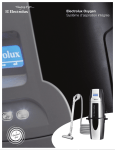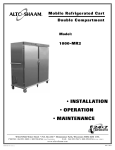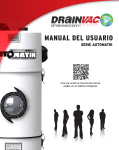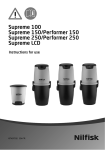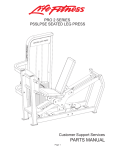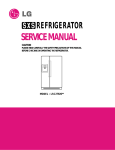Download Dyson D23 stowaway User guide
Transcript
dyson stowaway The full size cylinder with hygienic bin emptying helpline manual helpline manual Contents Page Features and benefits 3 Assembling and Operating 4 Carrying the machine 6 Bin emptying and Cleaning the shroud and washing the bin 7 Washing the pre-motor filter 8 Parts guide 9 Parts recognition (exploded diagrams) 12 Airflow 16 Filtration 16 Helpline diagnostics The Dyson 5 year guarantee 17 24 Features and benefits The full-size cylinder with hygienic bin emptying Root Cyclone technology™ + core separator Doesn’t lose suction and captures more microscopic dust than any other. Doesn’t lose suction and captures more microscopic dust. Cleaner exhaust air Air expelled from a Dyson has up to 150 times less mould and bacteria than the air you breathe. root cyclone Lifetime HEPA filter Ideal for allergy sufferers. core separator *More airwatts An extra 100 airwatts. Allows a bigger cleaner head for cleaning larger spaces. *Longer cable An extra 0.5 metres of cable. Clean a wider area without unplugging. *Bigger bin An extra 0.8 litres of bin capacity, so you don’t have to empty it so often. *Compared to DC22 Shroud Combines Root Cyclone™ technology with a core separator - an extra cyclonic stage between the outer and inner cyclones - to separate particles as small as 0.5 micron from the airflow. Hygienic bin emptying No need to touch the dirt just push the button. Low profile contact head Enables more thorough cleaning under furniture and appliances. Telescope Wrap system Hose and wand compress and wrap for easy storage. Sits on the stairs Follows you up the stairs as you clean them. helpline manual Assembling Extend telescopic wand handle ensuring both sections lock in place. (NB. The length of the telescopic wand handle is not adjustable.) Attach cyclone top and bin assembly. clik Slide hose into inlet. clik clik clik Clip hose retaining bracket into front of machine. Insert the floor tool into wand handle. Operating To start the machine press on/off button on the machine. To rewind cable, hold down the rewind button. 4 Operating Low profile contact head Press pedal to change between settings for delicate rugs/hard floors and carpets. helpline manual To prevent the low profile contact head from sticking to loose rugs open the bleeds on the underside. Power floor tool. (Motorhead variant only.) When you start the machine, the power floor tool is set to the brush ON mode. For delicate surfaces press the pedal to turn the brush bar off. To return to brush ON mode, press the pedal again. 5 helpline manual Operating clik clik Press the suction reduction button to prevent the wand handle from sticking to loose fabrics such as curtains. Accessory tools can be fitted to wand handle or hose as required. Carrying the machine Wrap the hose around the machine and fix the wand handle in place on the side of the cyclone assembly. Place the floor tool in the parking yoke at the rear of DC23. Always carry the machine by the handle on the cyclone assembly. 6 MAX MAX helpline manual Bin emptying Empty bin as soon as the MAX mark is reached. Option 1 Option 2 MAX Press catch to release cyclone and bin from the machine. Empty directly into dust bin. Emptying carefully into a bag is recommended for allergy sufferers. Cleaning the shroud and washing the bin To access the shroud, ensure the bin is empty and bin base is open. Press release button to remove bin. Clean shroud with a dry cloth or brush to remove fluff and debris. Do not use water. 7 You may rinse the clear bin with water (optional). Ensure bin is completely dry before refitting. Do not use detergents, polishes or freshening products. Do not immerse whole machine in water. helpline manual Washing the pre-motor filter Unplug and place machine on its side for ease of access. Turn release catch, lift the pre-filter cover and remove the pre-filter. 24 24 Rinse and squeeze filter under cold tap. Allow 24 hours to dry. Ensure filter is completely dry before refitting into machine. 8 helpline manual Parts guide Pre-motor filter Lifetime pre-motor filter. The pre-filter separates particles as small as cigarette smoke (0.1 microns). Should be washed every 3-6 months. 1 2 Telescopic wand The wand is telescopic and compacts for convenient storage. HEPA Post filter Kills bacteria and mould. 3 1. Brush tool 2. Crevice tool 3. Stair tool Hose The hose wraps around the machine for easy storage. Cyclone assembly Contains the shroud, which filters out fluff and hair, the core separator and the inner cyclones. Bin assembly Made from tough polycarbonate and is easy to empty (see page 7). 9 Low profile contact head Enables more thorough cleaning under furniture and appliances. helpline manual Parts guide Telescopic wand and Hose (Motorhead variant) The hose wraps around the machine for easy storage. Pre-filter cover Can be easily removed and refitted. (Supplied with wheel.) Mini turbine head Ideal for removing pet hair and fibres from confined spaces. End cap (Motorhead variant) Can be sent out and fitted by customer. Brush bar (Motorhead variant) Can be taken out to remove hair and fibre. Power floor tool (Motorhead variant) Uses direct drive belt that never needs replacing. Powerful bristles remove dirt and pet hair from carpet. 10 DC23 Parts guide: additional accessory tools Hard floor tool Improved pick-up on hard floors. Mini Flat-out Head Compact and low for cleaning under furniture and awkward spaces. Car turbine head Rotating bristles improve pick-up of pet hair in confined spaces. Flexi crevice tool Extends and flexes to clean awkward gaps. Soft dusting brush Soft bristles to gently dust around the home. Mattress tool Removes dirt and dust mites from mattresses and upholstery. 11 helpline manual Up top tool Revolving, multi-angular head designed to ease cleaning in awkward spaces. Stubborn dirt brush With stiff bristles for dried-in and stubborn dirt. helpline manual Parts recognition: Main body Cable Rewind Actuator Spring On/Off Actuator Switch Spring Screw Switch Housing Cable Rewind Assy Cyclone Release Catch Spring Screw Cyclone Release Catch Housing Upper Chassis Rear Hose Guide Screw Tool Storage Screw Park Yoke (Motorhead) Cyclone Inlet (Passive) Cyclone Inlet (Motorhead) Park Yoke Duct Cover Seal Cyclone Exhaust Seal Screw Screw Duct Cover Screw Motor Bucket Assy Wheel Assy Main Chassis Post Filter Seal Post Filter Assy Post Filter Exhaust Seal PCB Assy Castor Body Castor Roller Pre-Filter Housing Assy Pre-Filter Assy Axle Screw Motor Wiring Assy Bleed Valve Housing O-Ring Bleed Valve Cap Assy Bleed Valve Spring Screw Pre-Filter Door Assy Wheel Assy 12 Parts recognition: Cyclone assembly helpline manual Cyclone Assy Bin Assy Bin Base Seal FDC/IDC Seal Bin Base Assy 13 helpline manual Parts recognition: Wand and hose Screw Stubborn Dirt Brush Assy Wand Handle Cover Wand Handle Universal Fit Adaptor Screw Flexi Crevice Tool Assy Screw Universal Fit Adaptor Power Wand Hose Assy Hard Floor Tool Assy Wand Cuff Cover Screw Mini Turbine Head Assy Wand Handle Assy MTH End Cap Assy Swivel Catch Spring MTH Brushbar Assy Instruction Pack Swivel Catch Spring Turbine Head Assy Screw Brushbar Assy Hose Assy Soleplate Assy Fastener Crevice Tool Low Profile Contact Head Brush Tool Axle Stair Tool Soleplate Wheel 14 Parts recognition: Motor head floor tool helpline manual Screw Gimble Cover Axle Brushbar Actuator Washer Spring Glamour Cap Stow Microswitch Cam E-Clip Screw Outer Wheel Hub Stow Neck Cover Stow Wheel Internal Hose Assy Axle End Cap Assy Right Brushbar Motor Brush Housing Brushbar Motor End Mount Ropeseal Screw Ropeseal Brushbar Microswitch Floor Tool Bumper Strip Brushbar Motor Mount Front Brushbar Motor Cover Lower Brushbar Assy Screw End Cap Assy Left Soleplate Wheel Soleplate Assy Screw Axle Power Floor Tool Assy 15 helpline manual DC23 Airflow This section illustrates the direction of airflow through DC23. The dirty air flows through the wand and hose and then continues up the inlet and into the clear bin. The filtration process starts in the clear bin. Larger debris is separated from the airflow. The air is then directed through the shroud and up through the core separator and on into the smaller cyclones in the cyclone top. The air then travels down the exhaust duct before continuing through to the pre-motor filter and into the motor housing and up through the post-motor filter, where it is exhausted into the atmosphere, thoroughly clean. DC23 Filtration DC23 has a 6-stage filtration process: 1. O uter cyclone: as the air enters the clear bin, large dirt and debris is separated from the airflow. 2. S hroud: the air is then directed up through the shroud, which acts as a fluff and hair separator. 3. C ore separator: small/fine dust particles are then separated from the airflow in the core separator. 4. Inner cyclones: smaller/microscopic dust particles are then separated from the airflow in the inner cyclones. The air flows out of the cyclone assembly and into the duct, before reaching the pre-motor filter. 5. P re-motor filter: traps the last remaining particles of microscopic dust, allowing only clean air to pass through. 6. P ost-motor filter: lastly, as the clean air passes through the motor, it collects carbon dust particles from the motor brushes. The post-motor filter traps these particles before the air is then exhausted back into the atmosphere, thoroughly clean. 4 3 2 1 5 Lifetime pre-motor filter. The prefilter separates particles as small as cigarette smoke (0.1 microns). Should be washed every 3-6 months. 6 Lifetime HEPA post-motor filter. Never needs washing or replacing. 16 Helpline diagnostics helpline manual This section is a Helpline Operators guide to DC23 fault diagnostics and a checklist of procedures that should be carried out before booking a repair. In some cases, DC23 can be easily repaired over the telephone. If a customer reports any of the following faults listed below, go to the relevant page number. Always make sure you ask the customer to unplug the machine before carrying out any maintenance or checks (unless otherwise specified). Contents Page Loss of pick-up from the low profile contact head 18 Power floor tool brush bar not operating 20 Turbine head brush bar not operating 21 Machine cutting out: thermal cut-out 27 Unusual noises and smells 27 Power failure 28 Important advice CAUTION: If the fault is related to any electrical or mechanical issues, please ask the customer not to use the machine until a repair has been carried out. 17 helpline manual Loss of pick-up from the low profile contact head Carry out these checks if the customer reports low suction or loss of pick-up from the low profile contact head. For turbine head variants carry out the ‘Turbine head brush bar not operating’ checks on p.21 before continuing with checks from this section. Switch off and unplug the machine before carrying out these checks: 1 2 Remove hose from the inlet and switch machine ON. 4 Cyclone exhaust 3 Test suction from the inlet. If suction is weak continue with checks, if strong go to step 10. Switch machine OFF. 5 Intermediary Remove the cyclone and bin assembly. Check bin and cyclone for blockages or obstructions and make sure the shroud is clear of debris. 6 Bin entry FDC Seal Check bin entry and cyclone exhaust for blockages. 7 Open the pre-filter cover by turning the release catch. (The machine can be placed on its side for easier access.) Open bin base and check intermediary and FDC for blockages. Check seal is fitted correctly. 8 Check duct for blockages in the area shown. 9 Remove the pre-filter. Ask the customer to wash if necessary (when the call has ended). Ensure pre-filter is completely dry before refitting. 18 Ask the customer to refit the cyclone and bin assembly. Loss of pick-up from the low profile contact head helpline manual 10 11 12 Refit hose back into the inlet. Separate the hose from the wand handle. Switch machine ON and test suction from the end of the hose. If weak this indicates a blockage or possible damage to the hose. Reconnect the hose. Switch machine OFF and separate the low profile contact head from the telescopic wand. 13 14 15 Bleed tab Ensure that both sections of the telescopic wand are fully extended and locked into place. Check length of wand for damage. Check the suction release button for damage. Switch machine ON and test suction from the end of the wand. If weak this indicates a blockage or possible damage to the wand handle. Switch machine OFF. Bleed tab Check low profile contact head for blockages or damage. Check position of the bleed tabs. 19 Reassemble the machine and switch ON. If the machine operates as normal end the call. If not arrange a repair. helpline manual Power floor tool brush bar not operating The brush bar on DC23 Motorhead is powered by its own motor. The brush bar will stop rotating if it becomes obstructed. If the customer is advising that the brush bar is not operating or rotating, this maybe due to the brush bar motor cut-out. The brush bar motor will operate immediately, once the obstruction is cleared and the power floor tool reset. 1 2 Ask the customer to plug the machine in and switch ON. 4 3 Ask the customer to check if the brush bar is spinning. If spinning and customer is happy, end the call. If not ask customer to switch machine OFF and continue with these checks. 5 Press the release catch and separate the telescopic wand from the power floor tool. 6 Pins Connector Check that the pins on the power floor tool are not broken or bent and the connector on the telescopic wand is not damaged. 7 Check that the pins on the hose are not broken or bent and the connector on the inlet is not damaged. 8 Undo fasteners with a coin and remove both end caps. 9 Stow micro-switch Remove both brush bar sections and clear any hair/fibre. Check power floor tool for blockages. Check the stow micro-switch is not broken or obstructed. 20 Ask the customer to refit the brush bar and end caps. Switch machine ON, press brush bar ON/OFF button and test. If customer is happy end the call. If not arrange a repair. Turbine head brush bar not operating helpline manual The brush bar will stop rotating if it becomes obstructed. The brush bar will operate immediately, once the obstruction is cleared. 1 2 3 Inlet seal Plunger Press the release catch and remove the turbine head. Ask the customer to check the suction on the end of the wand handle. If weak go to section 1 on p.18, if strong continue with these checks. 4 Pull the brush bars out from the turbine head. Using scissors, carefully cut away any hair or threads from the brush bar. 7 Refit the soleplate and secure locking tab. Turn machine OFF and remove turbine head. Check inlet plunger for dust/ debris. Check inlet seal for damage. Undo both soleplate fasteners, release the locking tab. Lift and remove the soleplate. 6 5 Check the turbine duct for blockages. Check the metal spindles are rotating freely. 8 Position the brush bars back into the turbine ensuring the arrows on the brush bars are aligned with the arrow on the shaft. 9 Check that the soleplate is fitted flush against the housing with no visible gap. 21 Ask the customer to plug machine in and test that brush bar is spinning and the plunger is working. If not working send new turbine head. helpline manual Machine cutting out: thermal cut-out If the customer is advising that the main vacuum motor power has cut-out*, complete the checks below. Note, if the main vacuum motor has cut-out, it is likely the power floor tool (if applicable) will continue to operate. If the customer is advising that the power floor tool (if applicable) is not operating or rotating (but the main vacuum motor is operating), complete the ‘Power floor tool brush bar not operating’ checks on page 20. *Cutting out is when the machine loses power whilst in use. If the machine becomes blocked, it may overheat and will stop due to a thermal cut-out (fitted to the motor). The customer should follow the simple blockage checks below and allow a minimum of 30 minutes before re-using their machine. 1 Unplug machine. Separate telescopic wand from floor tool by pressing the release button. 4 3 2 Check low profile contact head for blockages. Cyclone exhaust 5 Separate the wand and hose. Check wand for blockages. 6 Intermediary Bin entry FDC Remove hose from inlet and check hose for blockages. 7 Check duct for blockages in the areas shown. Remove the cyclone and bin assembly from machine. Inspect the bin entry and cyclone exhaust for blockages. 8 Open bin base and check intermediary and FDC for blockages. 9 Open the pre-filter cover by turning the release catch. (The machine can be placed on its side for easier access.) 22 Remove the pre-filter. Ask the customer to wash if necessary (when the call has ended). Ensure pre-filter is completely dry before refitting. If machine is still not working arrange a repair. helpline manual Power failure Before completing these checks, it is important to determine whether or not the thermal cut-out has activated - was the machine in use when the power stopped? If so, follow the checks on page 22. Otherwise, carry out these checks if the customer has reported power failure. Note: If the customer advises you the machine was working intermittently - cutting in and out in quick bursts, as the machine is moving back and forth - arrange a repair, as this may indicate a cable problem. Also advise the customer not to use the machine until a repair has been carried out. 1 2 Ask the customer to unplug the machine. 5 Make sure the customer’s home has power. Check trip switch and fuse box. 6 3 4 Examine the plug thoroughly for damage or burn marks. Check the front and back of the plug. Check the length of the cable for wear and tear, such as splits or damage. Test the socket with a different appliance. *UK only. Make sure a 13 amp fuse is fitted. Also try a 13 amp fuse from a known working appliance. Note: 5 or 7 amp fuses will blow on initial start up due to motor current surge. 7 Has water or any other liquid been picked up which may have caused electrical problems? With the exception of the power fuse needing changing or a problem related to the power supply in the customers home, if the fault is any of the above, arrange a repair. Note: The Dyson guarantee does not cover wear and tear to the cable and plug, or the pick-up of liquids. Important advice CAUTION: If the fault is related to any electrical or mechanical issues, please ask the customer not to use the machine until a repair has been carried out. Unusual noises and smells Carry out the relevant checks if the customer reports any unusual machine noises or smells. • • • • If the noise is a loud, grinding sound, (possibly with strong odour), this may indicate a problem with the motor. A repair should be booked. Advise the customer not to use the machine until after a repair has been carried out. Also check the cleaner head for obstructions or damage. If the noise is a high pitched or whistling sound, complete the suction/blockage checks on pages (19-21) before booking a repair. If the customer reports a rattling noise, check to make sure that there is nothing rattling around in the clear bin. If the noise remains, carry out the blockage checks on pages (19-21), before booking a repair. If the customer reports a strong, electrical type burning smell, book a repair and advise the customer not to use the machine. If the smell is related to something that may have been picked up, carry out the blockage checks on pages (19-21). Also, ask the customer to wash the clear bin and pre-filter. 23 helpline manual Dyson 5 year guarantee Summary of cover Terms and conditions of the Dyson 5 year guarantee • • • • • • The guarantee becomes effective at the date of purchase (or the date of delivery if this is later). You must provide proof of delivery/purchase before any work can be carried out on your machine. Without this proof, any work carried out will be chargeable. Please keep your receipt or delivery note. All work will be carried out by Dyson or its authorised agents. Any parts which are replaced will become the property of Dyson. The repair or replacement of your machine under guarantee will not extend the period of guarantee. The guarantee provides benefits which are additional to and do not affect your statutory rights as a consumer. What is covered • The repair or replacement of your machine (at Dyson’s discretion), if your machine is found to be defective due to faulty materials, workmanship or function within 5 years of purchase (if any part is no longer available or out of manufacture, Dyson will replace it with a functional replacement part). What is not covered • • • • • • • • Normal wear and tear (e.g. Fuse, belt, brush bar, etc.). Accidental damage, faults caused by negligent use or care, misuse, neglect, careless operation or handling of the machine which is not in use with Dyson’s user guide. Blockages - please refer to the user guide for details of how to unblock your machine. Use of the machine for anything other than normal domestic household purposes. Use of parts not assembled or installed in accordance with the instructions of Dyson. Use of parts and accessories which are not Dyson Genuine Components. Faulty installation (except installation by Dyson). Repairs or alterations carried out by parties other than Dyson or its authorised agents. We’ll help you choose the right Dyson and give you any advice and assistance you need when you’re using it. You can contact us anytime at www.dyson.com or call our team of experts. 24 Technical helpline: Jai Uthup: Telephone: E-mail: +44 (0)1666 828393 [email protected] Neil Soutar: Telephone: Mobile: E-mail: +44 (0)1666 827302 +44 (0)7715 760813 [email protected] This controlled document contains CONFIDENTIAL information and must not be copied or distributed unless specifically authorised by the Dyson Technical Service Department. Its content is solely for the use of Dyson personnel or Dyson appointed representatives. DC23 Helpline Manual Produced by Dyson Technical Service. Issued: February 2008 The Dyson Research Centre, Wiltshire, UK


























